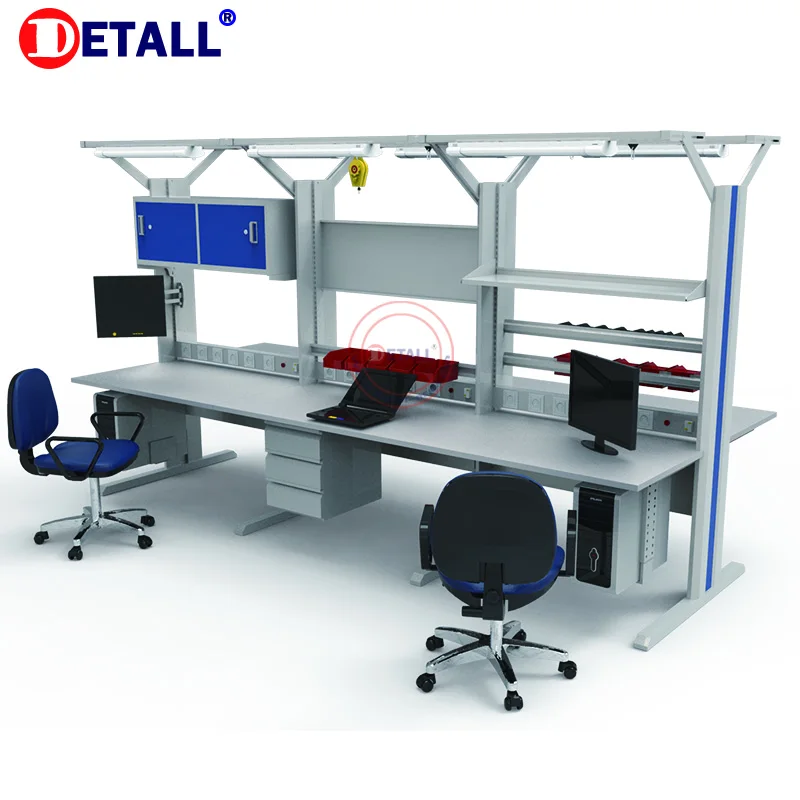
Its all just straight wood that is held together with screws (With glue in the joins just to be sure). All of it is made out of wood and uses no special joinery since im not a carpenter. The design and measurements ware tweaked a bit while it was made (A little shorter to make room for freestanding shelves and the shelf behind the table pulled out a bit to overhang). I hated having legs in the way too so i designed my new long workbench to not have any in the front apart from the ends that are next to the wall anyway. After using this kind of bench for a couple of decades now, I wouldn't have it any other way. Its also good to stick a 4 ft fluorescent lamp under there.

This scheme creates an empty space in the back of the bench that is 12 deep but it can be used for hiding other stuff such as a ntwk hub, main outlet box, isolation transformer or anything else you wont need to get at often. Adding an outlet strip across the front means I have no fear putting any heavy piece(s) of gear up there. All of the flat pieces are made with MDF and the frame is 2圆's.

That also adds support to the surface to stop it sagging. I fasten it with several particle board screws from the bottom and also along the sides and top. That puts the support near midway under the shelf. That is, if the bench is 48 in deep then the vertical long support for the shelf is about 36 in from the front edge of the bench. This long support is positioned about 10-12" towards the front of the rear edge of the bench. The bridge is held up by vertical panels on either end and by a vertical panel which runs the length of the bench under the bridge but not at the back of it. A few (*cough*) years ago I found a good way of building a "bridge" as the second story on such a bench to hold gear such as scope, sig generators, etc that may become quite heavy. My post is about 2/3 the way down the page. This is the electronics bench I built for myself a few years ago. Its also a good idea to have some general storage space near by in the form of a closet or shelving to store all your components and projects you are not working on. Good place to keep general tools, soldering consumables, a set of common resistor/cap values, test cables, probes etc. The shelves also are a great place to hold the stuff you often need, right in the reach of your hand. That way you can place test equipment on the shelf to get back your bench space. If you have a typical 60cm deep workbench and you put some 40cm power supply on it you are left with only 20cm of actual bench area to use as a bench! To solve this you want your bench to be as deep as possible, about 1m (3ft) is useful, or you can put shelves behind your bench like Dave has in his lab. While some of the new modern oscilloscopes take up a lot less space with there slimmer design, but bigger test equipment soon starts to pile up on it (Especially true if you buy old 20 year old test gear off ebay to get high performance stuff on the cheap). On top of all this you also want your test equipment on your bench so that its at hand when you need to use it. Not only for any project that grows big but also room around the project to put down components and tools as you are working on it. What you want there instead is lots of space. For that a thick heavy bench is great since it will stay in place under those large forces. Where you would want such a heavily built workbench is for a workshop where you might hammer stuff on it, put a vise on it etc. I know nobody likes a wobbly workbench, but with smart cross bracing much skinnier designs can be made solid. HOW LONG DOES A CUSTOM PRODUCT TAKE?ĭepending on the pace of approval and your material selection, the custom product design takes between 10-12 weeks on average.In my opinion the bench in the original post is too solid for electronics. The process takes an average of 10-12 weeks from ideation to shipping. Then, the custom piece will ship to your desired facility for installation. Upon your approval, the product moves into production. You can critique and tweak until the product meets your requirements. Your DC will collaborate with ID&E to create a two-dimensional product drawing. Send over your concept as a sketch or an image you found online.

A member of our ID&E team will work with you and your Design Consultant to bring your idea to life. Our team of industrial designers and engineers specialize in custom furniture design. WHAT IS THE CUSTOM PRODUCT DESIGN PROCESS? Read about how we helped our clients with custom furniture in our case studies. Formaspace custom workbenches and other products are created based on your operation, your operating shifts, and your specific workflow. A custom product is designed and engineered from scratch to meet your unique needs.


 0 kommentar(er)
0 kommentar(er)
